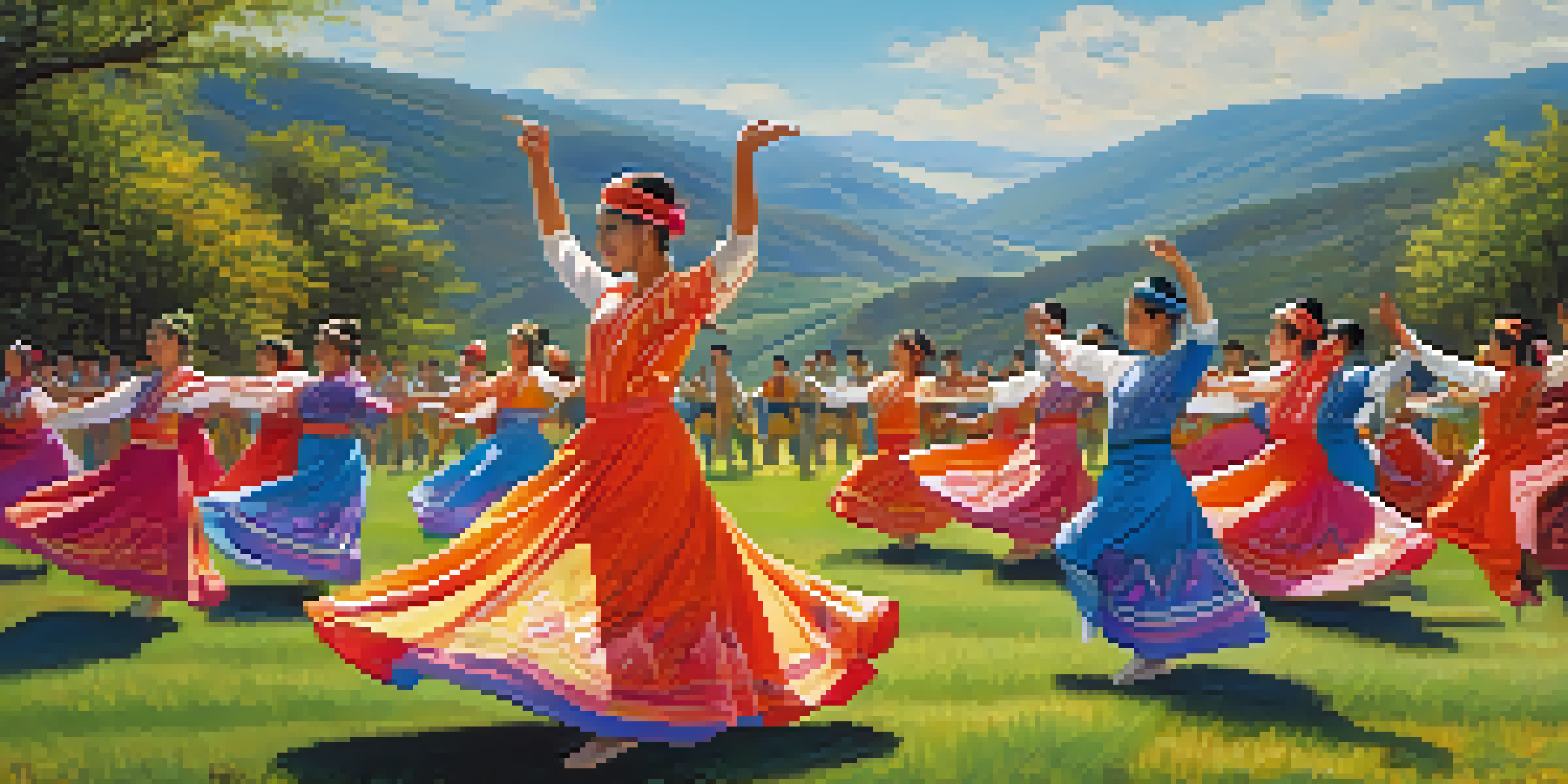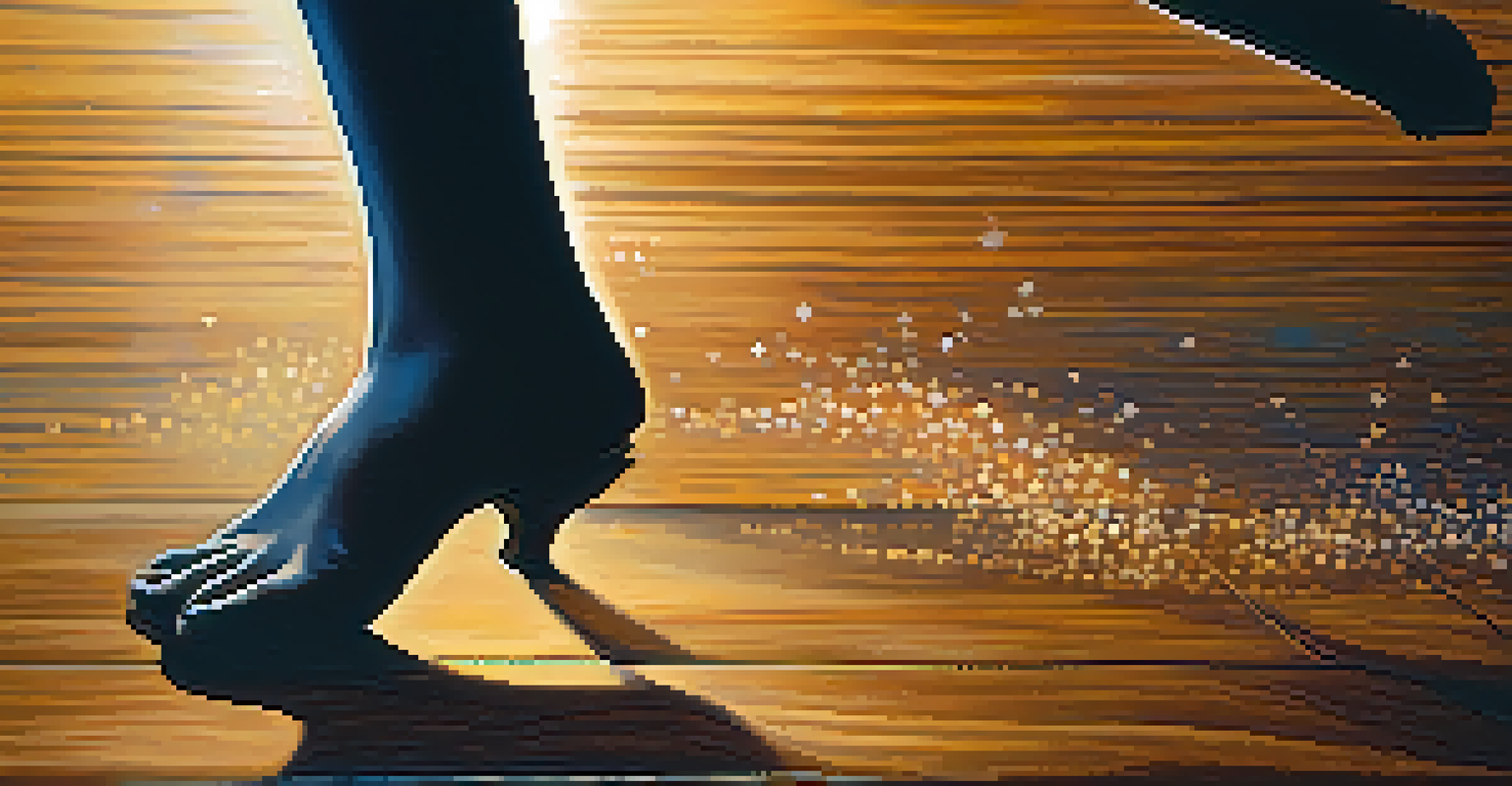The Influence of Folk Dance on Modern Performance Art

Understanding Folk Dance and Its Cultural Roots
Folk dance encompasses traditional styles that reflect the culture of a community. These dances often tell stories and celebrate local customs, making them a rich tapestry of human expression. For instance, the lively jigs of Irish dance or the graceful movements of ballet folklorico highlight the values and historical narratives of their respective cultures.
Dance is the hidden language of the soul.
In many ways, folk dance serves as a living archive, preserving history through movement. Each step and rhythm carries the weight of generations, connecting us to our ancestors. This cultural heritage is not only vital for the communities it represents but has also sparked interest among modern artists seeking inspiration.
Understanding these roots is crucial as we explore how folk dance influences contemporary performance art. By examining the mechanics of these traditional forms, we can appreciate how they have been adapted and transformed in modern settings.
The Evolution of Performance Art: A Brief Overview
Performance art, which emerged in the 20th century, is characterized by its emphasis on the artist's actions as the primary medium. Unlike traditional forms of art, performance art often incorporates elements of theater, dance, and visual art, making it a dynamic and multifaceted genre. Artists like Marina Abramović and Yoko Ono have pushed the boundaries of what performance can entail, engaging audiences on emotional and intellectual levels.

This evolution reflects society's changing values and the desire for more immersive experiences. As audiences seek deeper connections with art, performance art has increasingly looked to folk traditions for inspiration, reinterpreting age-old practices in innovative ways. This synthesis of old and new creates a dialogue between past and present, enriching the art form.
Folk Dance Preserves Cultural Heritage
Folk dance acts as a living archive, connecting communities to their historical roots through movement.
Understanding this evolution helps us see how contemporary artists can draw from folk dance traditions, integrating them into modern performance art. This connection not only revitalizes these traditions but also breathes new life into performance, making it accessible to diverse audiences.
Influence of Folk Dance on Movement and Choreography
At the heart of both folk dance and modern performance art lies movement, which serves as a universal language. Many contemporary choreographers have embraced the unique rhythms and styles of folk dance to create captivating performances. For instance, the dynamic footwork of African dance has inspired numerous modern dance pieces, showcasing the power of cultural exchange.
Culture is the widening of the mind and of the spirit.
These influences often emerge in the way performers use their bodies to communicate emotions and stories. By borrowing from folk traditions, modern artists can explore new ways of expressing themes such as community, heritage, and even social issues. This blending of styles facilitates a richer storytelling experience, making performances more relatable to audiences.
Moreover, incorporating folk dance elements can invigorate choreography with a sense of authenticity and spontaneity. As performers engage with these traditional movements, they not only honor their roots but also challenge the boundaries of contemporary dance, creating a vibrant fusion that resonates with viewers.
Cultural Exchange: Folk Dance in Global Performance Art
Globalization has led to an incredible exchange of cultural practices, and folk dance is no exception. As artists travel and collaborate across borders, they often incorporate elements of various folk dance styles into their work. This blending creates a rich tapestry of performance art that reflects the interconnectedness of our world.
For example, the incorporation of Indian classical dance into Western contemporary performances illustrates how diverse influences can coexist and create something entirely new. These collaborations not only enhance artistic expression but also promote understanding and appreciation of different cultures. They challenge stereotypes and build bridges between communities.
Performance Art Embraces Folk Traditions
Contemporary performance art increasingly draws inspiration from folk dance, blending traditional elements with modern storytelling.
Cultural exchange through folk dance in performance art also serves as a platform for dialogue about identity and heritage. By showcasing these traditional forms, modern artists can highlight the importance of preserving cultural diversity while also celebrating the beauty of innovation.
The Role of Technology in Modern Folk Dance Adaptations
In today's digital age, technology plays a pivotal role in how folk dance is perceived and integrated into modern performance art. Video recordings and social media have made it easier for artists to share and learn from folk traditions worldwide. This accessibility allows for a broader appreciation of these forms, reaching audiences far beyond their geographical origins.
Moreover, technology enables artists to experiment with new methods of storytelling through movement. For instance, augmented reality can enhance live performances, layering visual elements that complement traditional dance styles. This interaction between technology and folk dance creates a unique viewing experience that captivates contemporary audiences.
As artists continue to explore these possibilities, the fusion of folk dance and technology may lead to entirely new art forms. This evolution not only keeps folk traditions alive but also allows them to flourish in a modern context, ensuring their relevance for future generations.
Case Studies: Modern Performances Inspired by Folk Dance
Numerous modern performances draw directly from folk dance, showcasing its lasting impact on contemporary art. For instance, the acclaimed performance group Pilobolus often incorporates folk elements into their choreography, creating visually stunning pieces that celebrate movement and community. Their work demonstrates how traditional forms can adapt to modern sensibilities while retaining their essence.
Another example is the Broadway show 'Come From Away,' which integrates traditional Newfoundland step dancing into its narrative. This not only highlights the story's cultural context but also showcases the energy and joy of folk dance, inviting audiences to engage with the characters on a deeper level. Such productions exemplify the power of folk dance in enriching narrative and emotional depth.
Technology Enhances Folk Dance's Reach
Digital tools and social media allow folk dance to flourish and adapt, ensuring its relevance for future generations.
These case studies illustrate how modern performance art continues to be influenced by folk traditions. By weaving these elements into their work, artists honor their roots while creating something fresh and exciting that resonates with today's audiences.
The Future of Folk Dance in Performance Art
As we look to the future, the relationship between folk dance and modern performance art promises to evolve further. The growing interest in cultural heritage and authenticity among artists suggests that folk dance will continue to inspire new generations of performers. This trend could lead to a resurgence of traditional practices, reimagined for contemporary audiences.
Moreover, as global communication expands, we can expect even more cross-cultural collaborations that blend various folk styles into innovative performance art. This ongoing dialogue between cultures enriches the artistic landscape and fosters a sense of unity in diversity, celebrating our shared human experience.

Ultimately, the future of folk dance in performance art lies in its ability to adapt while remaining true to its roots. As artists explore and reinterpret these traditions, they will continue to create meaningful connections that resonate with audiences, ensuring that the spirit of folk dance endures in the modern world.